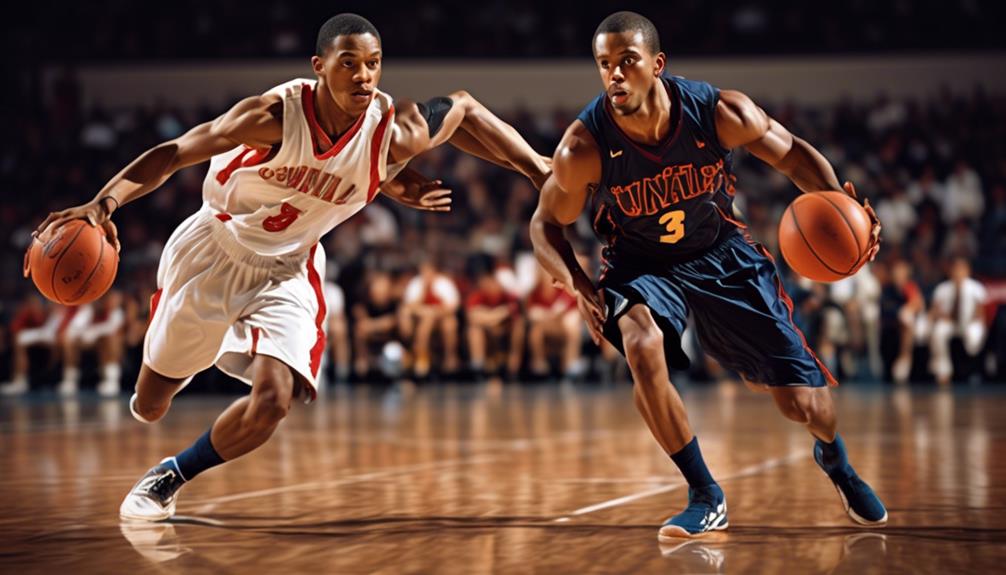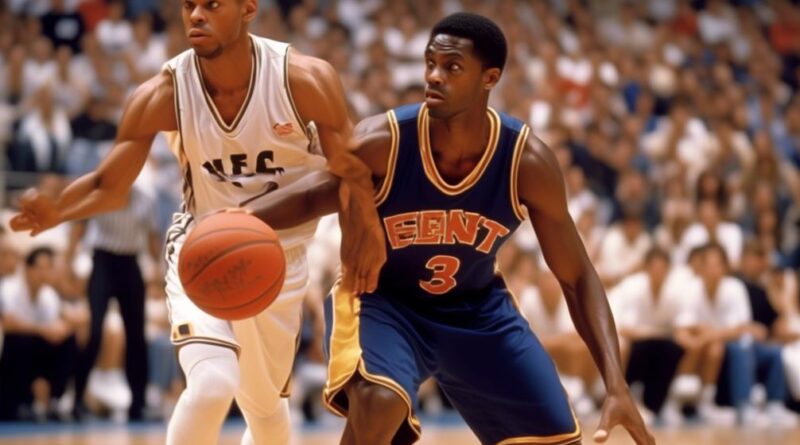Top Basketball Defensive Techniques for Mastery
To become a truly formidable defender in basketball, mastering the top defensive techniques is essential. While offense may get the glory, defense is often the deciding factor in close games.
So, whether you're a seasoned player looking to refine your skills or a newcomer eager to establish a strong defensive foundation, the key techniques and strategies you're about to learn will elevate your game to the next level.
The Importance of Defense in Basketball
Understanding the importance of defense in basketball is crucial for any player or team striving for success on the court. Developing a defensive mindset is essential for every player. It means being mentally prepared to anticipate the opponent's moves, staying focused, and being committed to stopping the other team from scoring.
A strong defensive mindset involves being disciplined, staying low in a defensive stance, and constantly being aware of the ball and your opponent's positioning. This mindset isn't only about physical skills but also about mental toughness and determination.
Another crucial aspect of defense in basketball is the importance of communication. Effective communication among teammates is vital for successful defensive plays. It involves constant verbal and non-verbal cues to ensure everyone is on the same page, covering the right areas, and switching players when necessary.
Clear and concise communication can prevent defensive breakdowns, help in double-teaming opponents, and ultimately disrupt the opposing team's offense. Without communication, there can be confusion and defensive lapses, leading to easy scoring opportunities for the other team.
On-Ball Defensive Techniques
Developing effective on-ball defensive techniques is crucial for every basketball player, requiring quick reflexes and precise footwork to stay in front of your opponent. To become a defensive powerhouse, you must master the defensive stance and positioning to effectively guard your opponent.
This involves keeping your feet shoulder-width apart, knees bent, and body low to the ground to maintain balance and agility. Additionally, positioning yourself between your opponent and the basket is essential to limit their scoring opportunities and force them into making mistakes.
Furthermore, mastering ball denial and pressure defense can significantly disrupt the opposing team's offense. By denying the offensive player easy access to the ball, you can frustrate their attempts to initiate plays, ultimately disrupting their team's rhythm and flow.
Applying pressure defense involves staying in close proximity to your opponent, making it challenging for them to execute their intended moves while constantly applying pressure to force turnovers. By incorporating these techniques into your defensive arsenal, you can become a formidable force on the court, earning the respect of your teammates and opponents alike.
Off-Ball Defensive Strategies
To excel in off-ball defense, focus on anticipating your opponent's movements and maintaining proper positioning on the court. Off-ball positioning is crucial in disrupting the opponent's offensive plays and creating turnovers. Defensive awareness is key to being in the right place at the right time to help your team's overall defense.
Anticipating where the ball is going and where your opponent is moving is essential for effective off-ball defense. Maintaining proper off-ball positioning involves staying between your opponent and the basket, denying easy passing lanes, and being ready to help your teammates when necessary. By being in the right position, you can apply pressure to the ball handler when they receive a pass, making it difficult for them to make plays and forcing turnovers. This requires constant awareness of the ball and your opponent, allowing you to anticipate their next move.
Defensive awareness goes beyond simply guarding your assigned player. It involves being mindful of the entire court, understanding the opponent's tendencies, and being ready to provide help defense when needed. By staying engaged and aware of both the ball and your opponent, you can make quick decisions and react effectively to defensive rotations and potential scoring opportunities for the opposing team.
Defensive Communication and Teamwork
Effective defensive communication and teamwork are essential components of a successful basketball defense strategy. When it comes to defensive communication, clear and concise instructions can help your team stay organized and focused. Utilizing specific communication strategies such as calling out screens, switches, and providing constant updates on offensive player movements can make a significant impact on your team's ability to shut down scoring opportunities.
Additionally, team coordination is crucial for maintaining defensive integrity. By working together and staying connected on the court, your team can effectively anticipate and counter offensive plays.
To improve defensive communication and teamwork, consider the following:
- Communication Strategies
- Use short and direct verbal cues to convey important information to your teammates.
- Establish non-verbal communication signals to communicate silently during noisy or intense game situations.
- Defensive Rotations and Help Defense
- Develop a system of defensive rotations to cover open players and protect the basket.
- Emphasize the importance of help defense and encourage players to provide support to their teammates when needed.
Defensive Footwork and Positioning
Improving defensive footwork and positioning can enhance your team's ability to execute defensive rotations and maintain effective communication on the court. Proper balance is essential for staying ready to move in any direction. When defending, keep your weight evenly distributed on the balls of your feet, allowing you to react quickly to your opponent's movements. By maintaining proper balance, you'll be able to stay agile and respond swiftly to changes in the offensive player's direction, making it harder for them to get past you.
In addition to proper balance, quick reactions are crucial for successful defensive footwork and positioning. Anticipating your opponent's moves and reacting swiftly can help you stay in front of them and prevent them from scoring. Keep your eyes on the opponent's midsection rather than the ball, as this can give you a split-second advantage in reacting to their movements.
When your opponent makes a move, whether it's a dribble, a pivot, or a shot, your quick reaction time will allow you to adjust your positioning and stay in control of the defensive play.
Rebounding and Box Out Techniques
When positioning for a rebound, focus on establishing a strong and stable base to effectively box out your opponent. This involves positioning yourself between the basket and your opponent, using your body to create space and prevent them from getting the rebound. To excel in this aspect of the game, consider the following techniques:
- Rebounding Techniques
- Positioning: Anticipate the trajectory of the ball and position yourself to be in the best spot to grab the rebound. This often involves quickly moving to the optimal location under the basket.
- Timing: Master the timing of your jump to snatch the ball at its highest point. This requires precise coordination and the ability to read the flight of the ball.
- Box Out Strategies
- Fundamental Footwork: Utilize proper footwork to establish a strong base and maintain balance while boxing out your opponent. This involves keeping your feet shoulder-width apart and maintaining a low center of gravity.
- Physicality: Use your body to create space and deny your opponent access to the ball. This requires a combination of strength, positioning, and anticipation to effectively box out your opponent.
Defensive Transition and Fast Break Defense

Transitioning from rebounding and box out techniques, now focus on maintaining defensive solidity during fast breaks and defensive transitions.
Transition defense is a crucial aspect of basketball that requires defensive urgency and quick decision-making. When the opposing team gains possession of the ball, it's essential to immediately switch from offense to defense and sprint back to protect the basket. Defensive urgency is key in preventing the opponent from capitalizing on fast break opportunities. This means all defenders must prioritize getting back on defense over offensive rebounding, ensuring that they're in a position to halt the fast break.
Fast break defense involves defensive rotations and communication among teammates. As the opposing team moves swiftly up the court, defenders must communicate effectively to identify assignments and cover any open players. When executed correctly, defensive rotations can disrupt the flow of the fast break and force the opposing team into a half-court offense, reducing their scoring efficiency.
It's imperative to maintain defensive discipline and not get caught ball-watching, as this can lead to easy scoring opportunities for the opposition.
Developing a Defensive Mindset
Embracing a relentless defensive mindset is essential for every player aiming to excel in basketball. Developing a defensive mindset requires mental toughness and a commitment to continuous improvement. Here's how you can cultivate a defensive mindset that will set you apart on the court:
- Mental Toughness
- Understand that defense is as much about mental strength as it's about physical ability. Embrace the challenges of staying focused and disciplined throughout the game, even when facing adversity.
- Practice visualization and positive self-talk to build resilience and confidence in your defensive abilities. Visualize yourself making crucial stops and disrupting the opposing team's offense.
- Defensive Mindset Development
- Study the game and your opponents to anticipate their moves and tendencies. Knowledge is a powerful tool in developing a proactive defensive approach.
- Embrace the role of a defensive leader on your team. Communicate effectively, stay engaged, and set the tone for your teammates with your unwavering commitment to defense.
Developing a defensive mindset is a journey that requires dedication and a willingness to embrace discomfort. It's not just about physical skills; it's about mental resilience and strategic thinking. By focusing on mental toughness and actively developing your defensive mindset, you can elevate your performance and make a lasting impact on the game.
Frequently Asked Questions
How Can Players Improve Their Reaction Time and Quickness on Defense?
To enhance your reaction time and quickness on defense, focus on defensive footwork and agility drills. Engage in reflex training to improve defensive anticipation. By practicing these techniques consistently, you'll develop sharper defensive skills on the court.
What Are the Best Ways to Defend Against Taller or More Athletic Opponents?
To defend against taller or more athletic opponents, focus on footwork fundamentals and defensive positioning. Use physicality and anticipate their movements to disrupt their offense. Stay low, move quickly, and stay disciplined in your defensive approach.
Are There Specific Defensive Techniques for Shutting Down a High-Scoring Player on the Opposing Team?
To shut down a high-scoring player, focus on mental toughness and defensive positioning. Communicate with your team and anticipate the opponent's movements. Use these techniques to effectively challenge and limit the impact of the opposing player.
How Can a Team Improve Their Overall Defensive Chemistry and Coordination?
To improve your team's overall defensive chemistry and coordination, focus on building trust, communication, and team positioning. Encourage help defense and emphasize the importance of working together to shut down the opposing team's offense.
What Are Some Advanced Defensive Strategies for Handling Pick and Roll Situations?
When handling pick and roll situations, focus on switching strategies, communication techniques, trap and recover, and hedge and recover. Work on seamless switches, clear communication, and quick recoveries to effectively defend against the pick and roll.
Conclusion
So, now that you know the top basketball defensive techniques for mastery, it's time to put them into practice.
Remember to focus on your footwork, positioning, and communication with your teammates.
Developing a defensive mindset will set you apart on the court.
Keep working hard and stay disciplined in your defensive efforts.
With dedication and practice, you can become a defensive powerhouse in basketball.
Good luck!
